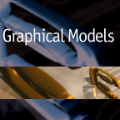In Statistical Relational Artificial Intelligence, a branch of AI and machine learning which combines the logical and statistical schools of AI, one uses the concept {\em para\-metrized probabilistic graphical model (PPGM)} to model (conditional) dependencies between random variables and to make probabilistic inferences about events on a space of ``possible worlds''. The set of possible worlds with underlying domain $D$ (a set of objects) can be represented by the set $\mathbf{W}_D$ of all first-order structures (for a suitable signature) with domain $D$. Using a formal logic we can describe events on $\mathbf{W}_D$. By combining a logic and a PPGM we can also define a probability distribution $\mathbb{P}_D$ on $\mathbf{W}_D$ and use it to compute the probability of an event. We consider a logic, denoted $PLA$, with truth values in the unit interval, which uses aggregation functions, such as arithmetic mean, geometric mean, maximum and minimum instead of quantifiers. However we face the problem of computational efficiency and this problem is an obstacle to the wider use of methods from Statistical Relational AI in practical applications. We address this problem by proving that the described probability will, under certain assumptions on the PPGM and the sentence $\varphi$, converge as the size of $D$ tends to infinity. The convergence result is obtained by showing that every formula $\varphi(x_1, \ldots, x_k)$ which contains only ``admissible'' aggregation functions (e.g. arithmetic and geometric mean, max and min) is asymptotically equivalent to a formula $\psi(x_1, \ldots, x_k)$ without aggregation functions.
翻译:在“ 可能的世界” 空间中, 一个包含 $D (一组天体) 的 AI 和 机器学习分支, 可以由 $\ mathbf{W ⁇ D$ 和 AI 的逻辑和统计系组合起来, 使用概念 $em para\ metrical 概率图形模型( PPGM) 来模拟随机变量之间的有条件依赖性, 并对“ 可能的世界” 空间中的事件进行概率推论。 一组含有 $D( 一组天体) 的可能世界可以由 $\ mathbf{W ⁇ D$ 和 机器学习 来代表 将所有一阶结构( 适合的签名) 的 美元和域的 $D$ 。 使用一个正式逻辑来描述 $\ malphild= 的 时间值, 我们可以用 $\ malx 的数值来描述事件 。 使用 max max 公式 的最小值计算法 。 然而, 以 ral dealal dealal dalal dal dal oralaltialtial max disal 。





